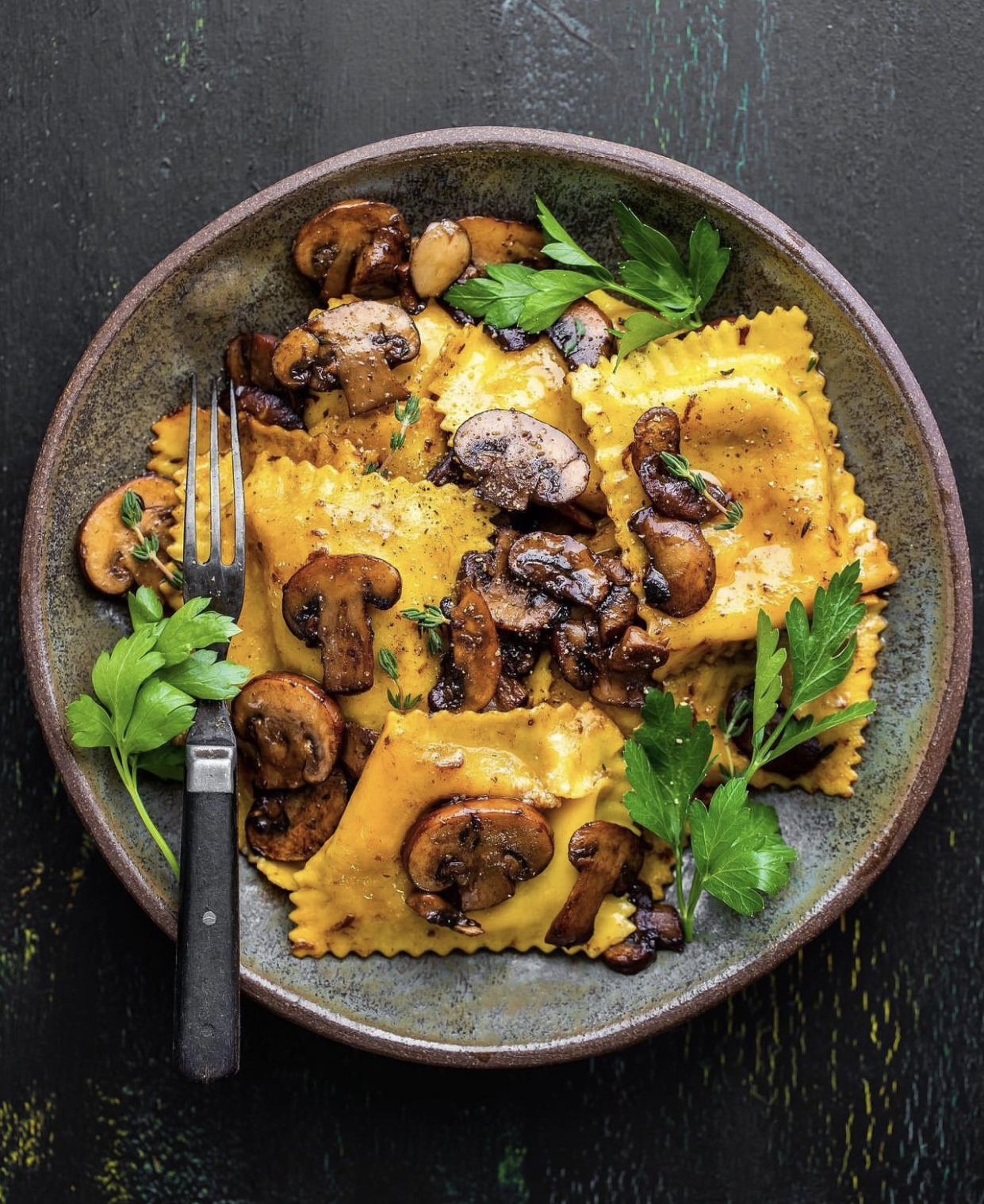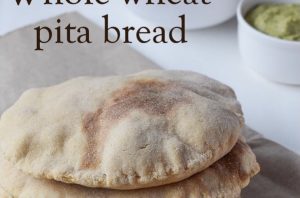It’s really easy to tell people the following advice:
“To lose weight, just eat more REAL food.”
“Just eat less fast food and junk food.”
“Try to eat more organic vegetables watered by unicorn tears, farm-to-table meals served by centaurs, and kale omletes made with eggs from chickens that you raised since birth.”
Okay so maybe people don’t say the last one.
But it’s not far from what healthy people say to people who can’t seem to get healthy.
In my opinion, these positions are completely out of touch with reality and it makes me plum dog mad.
For starters, fast food is crazy delicious and dirt cheap, and often the only way that many busy parents can feed themselves and their kids.
Next, applying morality and guilt to food consumption (“I’m being ‘so bad’ by eating this cookie”) creates an emotional rollercoaster – my least favorite kind of roller coaster.
I mean come on, we don’t need to be told that freshly grown fruits and veggies are better for us than junk food.
We don’t need to be told that organic grilled chicken and kale salad is healthier than a Double Whopper with Cheese.
We all know this!
So rather than “trying harder” to eat healthier we’re going to use things like “science” and “human psychology” and “excessive quotation marks.”
Cool?
Here’s what you need to know: If you’re just trying to be healthier and maybe lose some weight, there’s no need to start funneling kale smoothies, mainlining chicken and broccoli, and abandoning your loyalty to the Burger King.
You can lose weight and be healthy while still eating these foods occasionally.
Heck, people have lost weight by eating Twinkies[2] and drinking soda and eating at McDonald’s 3 times per day.
I share this info not to promote those foods, but rather to make a big point:
If you are terrified of giving up all “junk food”…
You do not need to give up fast food if it brings you joy.
You do not need to feel shame for eating ice cream.
You do not need to use terms like “cheat meal” or “guilty pleasure” when talking about a chocolate chip cookie.
Food isn’t good or evil, my dear friend!
It’s just food!
Let’s bring it all together:
If we have certain health goals, we can give ourselves the best chance of success by getting strategic about what foods we say “YES” to, and what foods we say “SOMETIMES” to.
These YES foods give us more energy and have fewer calories on average than “junk food,” which means we’re likely to eat fewer total calories without realizing it.
And thus, we end up with the Triforce of Awesome:
* A longer lifespan.
* A smaller waistline.
* A happier, healthier existence.
So what are these magical foods we’re talking about?
I thought you’d never ask.
What is Healthy Eating?
Removing all the morality and science of food, let’s talk about a realistic definition of “healthy food”:
“Foods I can eat frequently that give me enough fuel to get through the day AND don’t make me miserable.”
Most doctors, websites, and books have generally the same list of “healthy foods”:
* Protein like poultry, meat, low-fat dairy, and legumes.
* Fruits and vegetables.
* Healthy carbohydrates like rice and quinoa.
* Healthy fats like almonds and olive oil.
* Occasional full-fat cheese and dairy.
(A more complete list of healthy foods is below).
Why is it that these are the foods that happen to end up on every list on every website when it comes to “healthy eating?”
Simple.
They are full of vitamins and minerals while also being lower in calories than ultra-processed foods that are easily overconsumed.
They also fill us up, making us feel satiated, and keep us under our calorie allotment for the day.
Now you’re starting to get it:
If we can prioritize these foods on our plate even occasionally, we’ll feel full more often while eating fewer calories…
Which leads to sustainable weight loss and maintenance!
Let me drive this point about into your brain (not literally).
Each of the following foods can contain 200 calories depending on quantity
Apples
Turkey
Pasta
Broccoli
In this context, the realization that we might overeat certain foods compared to others starts to become more clear:
* If we accidentally overeat broccoli, we might eat an extra 20 calories. And who accidentally overeats broccoli?
* If we accidentally overeat spaghetti, we might eat an extra 500-1000 calories.
* If we accidentally eat a family-sized bag of Sour Patch Kids, we might eat an extra 2000 calories (and have no tastebuds left on your tongue)
Which brings me to the next point
We humans are terrible at estimating how many calories we eat.
Like, really really bad at it. I bet the proportions of the above foods surprised you.
We consistently eat much more than we realize, by as much as 47%+.
To make matters worse, we also OVERestimate how many calories we burn through exercise.
One study showed that Fitness trackers like AppleWatch or Fitbit do not estimate energy burned through exercise accurately, some by as much as 90%.
So when we “can’t lose weight,” it’s not because we have a broken metabolism.
It’s not because we have bad genetics.
Or that we’re not eating for our blood type.
It’s because we consistently eat too much food without realizing it.
Because we always have a ready supply of new energy from recently eaten food, more than we need, our body NEVER has to dip into our stored fat to burn for fuel.
And when we think we’ve out-exercised our bad diet, we really haven’t.
So it’s time to stop “trying harder” and instead “try differently”:
In order for us to get healthy, we need to find ways to include more foods that fill us up AND taste good.
Luckily, I have that list riiiiight here!
How to Start Eating Healthy (Healthy Food List)
There are three big macronutrients that we’re going to focus on as we build our plate like the image above:
* Protein: building blocks for our muscles.
* Carbohydrates: our bodies will burn as fuel.
* Fats: can be burned as fuel, and also helps with nutrition absorption!
#1) PROTEIN: Priority Numero Uno.
Protein is amazing.
Your body uses protein to rebuild your muscles and keep you strong, especially if you are exercising or strength training regularly.
Protein is both good for you AND highly satiating.[13]
Protein can come from any number of sources, including:
* Meat (beef, bison, pork).
* Poultry (chicken, turkey, duck).
* Eggs![14]
* Fish and shellfish (salmon, tuna, shrimp).
* Legumes (black beans, chickpeas).
A serving of protein is about the size and thickness of your palm.
When building a plate, aim for the following amount of protein:
* Dudes: 1-2 servings (6-8 oz or about 170-228 g): two palms
* Dudettes: 1 serving (3-4 oz or about 85-114 g): 1 palm.
If you’re curious, here’s how much protein is in a serving of food:
* 4 oz (113 g) serving of chicken has around 30 g of protein.
* 4 oz (113 g) serving of salmon has 23 g of protein
* 4 oz (113 g) of steak has 28 g of protein.
As we cover in our “how much protein should I eat per day?” you can target anywhere from 80% to 100% of your bodyweight in pounds per gram of protein, with an upper limit of 250g[15]:
* If you weigh 150 pounds (68 kg), target 120-150g of protein.
* If you weigh 200 pounds (90 kg), target 160-200g of protein.
* If you weigh 250 pounds (113 kg), target 200-250g of protein.
* If you weigh more than 250 pounds (113 kg), target 250g of protein.
#2: VEGETABLES: The difference-maker when it comes to healthy eating and weight management.
They are nutrient-dense: full of all the good nutrients that your body can use to function at optimal performance.
Next, they are voluminous but calorie-light, which means you can eat lots of them, you’ll feel full, but you’re unlikely to over-consume calories.
A serving of veggies is about the size of your fist.
Remember 200 calories of broccoli is huge (holy crap). It’s at least 5 full servings:
Here’s a quick, non-complete list of veggies that can fill your plate:
* Broccoli
* Broccolini
* Cauliflower
* Spinach
* Kale
* Spaghetti squash[16]
* Brussels sprouts
* Zucchini
* Cucumber
* Carrots
* Onion
* Asparagus
Target 2 servings of vegetables on your plate – it should take up ½ the plate!
“But Steve, I don’t like vegetables…yet!”
That’s cool, I didn’t eat vegetables until I was 22. Now, they’re a main staple of every meal I eat.
To recap portion sizes of protein and vegetables:
#3) HEALTHY CARBOHYDRATES: Fuel and fiber!
These are the foods that can be an important part of a diet, provided you eat them in the right quantities for your goals.
These foods are also great to consume right after a strenuous strength training workout to help your muscles and liver refill their glycogen stores (their energy tanks[17], essentially).
Examples of healthy carbohydrates:
* Rice
* Legumes, lentils
* Quinoa
* Potatoes
* Sweet potatoes
* Yams
* Whole grain bread (or pasta)
This is a list of REAL food, minimally processed, that also have plenty of fiber[18].
If you’re wondering how fruit factors into this equation, that’s the next section.
Back to healthy carbs: when consumed in appropriate amounts, these are great foods that can help you feel full and give you energy and all that jazz.
Just make sure you know what an actual portion of these foods are!
A LOT of people accidentally overeats carbohydrate-heavy foods, even healthy ones, and then wonders why they aren’t losing weight.
To help you get better at eyeballing serving sizes:
1 serving of a starchy carbohydrate is 1 cupped hand (uncooked), or your two hands forming a cup (cooked).
#4) HEALTHY FATS: No longer the enemy!
Fat had a bad rep in the 70s, 80s, and 90s, but now things are swinging wayyyyy back in the other direction.
In some circles, dietary fat is considered a superfood – the healthiest thing on the planet that also does your taxes for you.
Let’s get to the truth:
Fat is neither a superfood nor evil.
It’s just a macronutrient that you can eat that can help you reach your goals in the right quantity, or keep you from your goals if it’s overconsumed.
When your doctor tells you to eat more healthy fats, she’s referring to polyunsaturated and monounsaturated fats[19].
Healthy fat can be found in foods like:
* Avocado
* Almonds
* Walnuts
* Macadamia nuts
* Olive oil
* Almond butter
* Peanut butter
Now, science has recently come around on saturated fat too[20] – once completely vilified, but now cautiously considered okay for moderate consumption.
Saturated fats can come from things like:
* Whole milk
* Full fat dairy
* Coconut oil
* Grass-fed butter
* Lard
* Fatty cuts of meat
Fat can be good for you provided you’re eating the right quantity for your goals.
However, like carbs, fats can be overconsumed accidentally too.
To help you gauge: a serving size of fat is roughly the size of your thumb!
if you’re not careful – you can accidentally eat an extra 500 calories of “healthy fats” by absentmindedly eating too many “heart-healthy” fats.
Many folks in our Coaching Program had us analyze why they weren’t losing weight, even though they “only ate grilled chicken and veggies.”
When we dug into it, they had been preparing all of their food in an extra 500-600 calories worth of olive oil they weren’t accounting for.
To recap carbs and fats: feel free to include a starchy carb on your plate in the form of rice, potatoes, pasta, or legumes. Healthy fats can spice up a meal, provided you’re using an appropriate portion size
I realize that was a CRAZY amount of info, so let’s put it all on the same Healthy Plate:
* 1-2 servings of protein (¼ of plate)
* 2 servings of vegetables (½ of plate)
* 1 serving potatoes, rice, or pasta. (1/4th of plate)
* 1 serving of fat (size of your thumb)
* 1 zero-calorie or low-calorie beverage (water, diet soda, tea)
I know that not all of your meals are going to be perfectly segmented like a bento box. For example:
* A fatty cut of meat like chicken thighs means your fat and protein are commingling. Cool.
* Lentils and legumes mean your protein and your carbs are attached at the hip. Swell.
* A burrito bowl with chicken, rice, guacamole, and cheese means all of your macros are cohabitating. Neato!
* Salmon cooked in olive oil and coated in almond flakes means your fat and protein have fused. Stupendous!
This plate and serving size stuff above is just to help you get started thinking about healthy food differently and in proper portion sizes:
* Trying to lose weight? Reduce your portions of carbs and fats.
* Trying to gain weight? Increase your portions of carbs and fats!
Remember, all calories count.
I can already predict your next series of questions:
* “What about beverages?” Simple. Liquid calories count too. So stick to low or zero-calorie drinks like water, tea, coffee, and diet soda.
* “How about condiments?” Grilled chicken slathered in 1000 calories of buffalo sauce means you’re still eating a calorie bomb!
* “But what about things like Paleo or Keto? I thought low carb = healthy?” I address that in the “which diet is right for me?” section. Keep reading.
What’s the Deal with Fruit? Is Fruit Healthy?
As we lay out in our “Is Fruit Healthy?” Guide, fruit is absolutely healthy and can help you reach your goals – in the right quantities.
Fruits are full of nutrients, packed with fiber, and can make for a great snack or part of a protein-focused breakfast!
Personally, I blend up frozen mixed berries in my post-workout smoothie.
Just remember that fruit, like every other food, obeys the laws of thermodynamics.
So, simply be aware of the calories (and carb and fiber content if you’re following a lower-carb diet).
Here’s a list of the calorie, carbohydrate, and fiber content of some common fruit:
* Apple: 95 cal, 25g carbs, 4.4g fiber.
* Banana: 105 cal, 27g carbs, 3.1g fiber.
* Orange: 45 cal, 11g carbs, 2.3g fiber.
* Pear: 100 cal, 28g carbs, 3g fiber.
* Peach: 59 cal, 14g carbs, 2.3g fiber.
* Strawberries (1 cup): 47 cal, 11g carbs, 3g fiber.
* Pineapple (1 cup): 82 cal, 22g carbs, 2.3g fiber.
* Grapes (1 cup): 62 cal, 16g carbs, 0.8g fiber.
* Raspberries (1 cup): 65 cal, 15g carbs, 8 fiber.
Fruit is a better, healthier alternative to nutrient-empty food from a vending machine.
Where fruit can get you in trouble is if you start to move in the direction of “fruit-like”:
#1) Fruit juices (cranberry juice, orange juice, grape juice): these are high calorie, sugar-filled beverages.
For example, here are the calories in one 8 oz (or 1 cup)serving of:
* Apple Juice: 114 calories[22]
* Orange Juice: 119 calories[23]
* Grape Juice: 14 calories[24]
#2) Dried fruit: notoriously easy to overeat because they are so small. Since the water has been taken out, all that’s left is the sugar and fiber.
Here’s 1 serving of raisins, which is 108 calories and 21 g of sugar:
If you are saying “oh man, I eat 5x that many raisins when I eat them…” then multiply those calorie and sugar numbers by 5!
3) Fruit Smoothies: Just because it’s a fruit smoothie doesn’t mean it won’t make you fat! Have you seen the calorie count and sugar content of smoothies and ‘green drinks’? Yikes.
* Green Machine Naked Juice (15.2 oz or 450 ml bottle): 270 calories, 53 g of sugar.
* Smoothie King Banana Boat (20 oz or 591 ml smoothie): 450 calories, 70 g of sugar.
To recap: fruit is healthy, provided you stick to fresh or frozen and not fruit-like food, dried fruit, or canned fruit packed in syrup.
If you enjoy a small glass of orange juice occasionally, or you pack a serving of raisins in your lunch and it makes life worth living, by all means!
Just don’t chug OJ by the gallon, drink a 64 oz “real fruit smoothie,” and eat raisins by the handful and then wonder why you’re not losing weight.
Are Cheese and Dairy healthy?
We get questions about these two types of food frequently.
Let me start by saying I’m assuming you’re not doing Paleo (which says “NO dairy and NO cheese”), or plant-based (which says NO to all animal products).
I’ll also assume you’re not doing Keto, which almost requires you to load up on dairy and cheese to eat enough fat every day!
Let’s pretend you’re just curious if cheese and/or dairy can be consumed on a “healthy diet:”:
YES, you can still eat cheese and be healthy.
YES, you can still eat dairy and be healthy.
And there was much rejoicing:
Like the healthy carbs and fats listed above, it all comes down to your calories consumed in a day, and if these foods fit into your daily calorie goals:
1. Want to put cheese on top of your salad of chicken and vegetables? Great!
2. Want to eat greek yogurt, a scoop of protein powder, and frozen berries for your breakfast? Amazing!
3. Want to eat a bowl of cereal with skim milk (or whole milk) in the morning with your kid before school? No problem.
This is true for higher-fat cheeses or full-fat dairy too – the food just needs to fit into your goals!
Luckily, all dairy comes labeled, and most cheese will come with a nutrition label on it too.
Just ensure that you’re choosing appropriate portion sizes
And although nobody in the history of the world has ever eaten just one serving…here is a serving of ice cream:
A scoop of ice cream the size of a tennis ball is about 127 calories.
So, dairy and cheese are both perfectly acceptable healthy food options! Just make sure they fit into your goals.
If you are NOT losing weight, and you consume a lot of dairy and/or cheese, consider measuring your intake and see if it’s in line with your expectations!
What’s the Best Diet for Me? Keto vs Paleo vs Plant-based.
Low fat diets? Low carb diets? No carb diets? I don’t know which one is the BEST diet!”
“Help me, Steve Kamb, you’re my only hope.”
Okay, you’re probably not saying that, but it’s an excuse to pay homage to Star Wars so I can use the great photo above.
You probably do have questions though about what’s healthier, a low fat diet or a low carb diet.
Low carb diets are all the rage right now, but are they healthy and will they help you lose weight?
Maybe.
It may depend on how your body regulates glucose (blood sugar):
Some who don’t regulate glucose well may do better on a lower-carb diet.
Others who do regulate glucose well might do better on a lower-fat diet.
Studies show that people who follow EITHER a low fat OR a low carb diet will still lose weight, as long as they are in caloric restriction and can adhere to the diet for at least a year.
So, it comes down to: “which diet are you more likely to stick with for a year or longer?”
I personally lost 22 pounds over 6 months on a lower-fat diet (and eating plenty of carbs), but everybody is different.
This means you’ll need to experiment and see which is better for your lifestyle, and your day-to-day well-being.
All the diets above have a clever way of restricting calories without you needing to count calories, which leads to weight loss:
* Paleo Diet: eliminate everything but veggies, meat, fruit, and nuts.
* Intermittent Fasting: skip an entire meal!
* Keto Diet: remove an entire macronutrient from your diet (carbs).
* Military Diet: Only eat specific foods in certain quantities.
* Plant-based Diet: Only eat foods from plants.
* Carnivore Diet: Only eat meat! Eliminate everything else.
Of course, there are plenty of benefits from following certain diets for certain groups of people. For example, Larry went Keto and it helped him reduce inflammation from rheumatoid arthritis.
However, 99% of the reason why these diets result in short-term weight loss is that they get us to eat fewer calories!
The problems arise when we get to Truth 2:
“Nearly every diet fails in the long term.”
Put another way:
Temporary changes create temporary results.
If somebody “goes Keto” for 60 days, they’ll most likely lose weight, and might even feel better! This is cool.
BUT!
(There’s always a but…)
If they spend those 60 days in misery, dreaming of carbs, counting down the meals until they can “go back to eating like normal,” they will put all of the weight back.
In order for restrictive diets to create permanent results for somebody, they need to be adopted PERMANENTLY!
For most of us mere mortals, we can’t stick with a restrictive diet for 30 days, let alone a year or a decade.
For these reasons, I strongly advise you to change how you think about dieting.
You need to determine how likely you are to stick with a restrictive diet permanently:
1. How averse are you to change?
2. How likely are you to stick with your changes?
3. Have you tried a restrictive diet in the past and failed?
4. Do you have a healthy relationship with food?
5. Do you have an “all or nothing?” mindset?
Like playing a video game, you need to determine what level of difficulty you are willing to attempt.
Playing on “Ultra Hard Difficulty” (like Keto) gives you less room for error, but it can also produce impressive results quickly – if you don’t rage quit.
And 99% of people rage quit restrictive diets like Keto.
So what’s the best diet for you?
I’ll give you the same answer that I give people when they ask me, “What’s the best workout plan?”:
The best diet is the one that helps you reach your goals, that you ENJOY, and that you’ll actually stick with permanently!
Personally, I don’t follow any sort of restrictive diet.
I’m a big fan of small changes that eventually produce big results, like my boy Optimus Prime:
This is why I’ve SLOWWWWLY adjusted my diet over the past decade, so that no change was too drastic and I could stick with it permanently.
It’s not a diet. It’s a lifestyle change. Permanently.
And that’s what I would recommend for you:
Small, non-scary, permanent changes over a long time period!
You need to start thinking in terms of “days and years,” not “weeks and months:”
Okay! Now that you’ve determined your healthy eating strategy, it’s time to take action.
There are three big steps you’ll want to master if this is your path:
STEP #1: GROCERY SHOPPING!
Here’s how to grocery shop like a pro:
* Stick mostly to the outer rim. This means you’re mostly buying meat, fruit, and veggies[28].
* Read the nutrition label! Just because it says it’s healthy on the front doesn’t mean it is. Read the nutrition label and learn portion sizes. This can help keep you below your daily calorie goal.
* Don’t shop hungry! It may seem silly, but you end up buying way more junk food accidentally if you shop while hangry (a mix of hungry-angry, never a great emotion).
* Make a list. Before you go grocery shopping, write down everything you should get. You can even put “non-healthy” food items on the list. But then you can only buy what’s on your list! This means no candy in the check-out aisle, or buying Oreos just because they’re on sale! Plan ahead. Stick to the script, sister.
STEP #2: LEARN TO COOK!
In the next section, we share recipes for basic healthy meals that you can cook at home.
Here’s why cooking at home is amazing:
1. You know all of the ingredients. When you eat at restaurants or pick up fast food, there are often hidden calories in the cooking oils and sauces that are sabotaging your healthy efforts. Because of this, it’s really hard to have an idea of how many calories you’re consuming. When you prepare food at home, you know what you’re getting.
2. You can recreate healthier versions of your favorite foods. Making homemade tacos or pizza with homemade dough can be a great date-night experience, makes your stomach happy, AND can help you reach your goals!
3. You save money. If your budget is tight, grocery shopping and cooking your own meals is a great way to balance your budget and free up some cash! Our most successful coaching clients work with their coaches on building the habit of cooking at home.
Now, if you’re somebody who only ever uses your kitchen to heat up microwave meals, that’s no problem.
STEP #3 (BONUS): MEAL PREP AND BATCH COOKING!
This step isn’t necessary, but if your goal is to make healthy eating a habit for you and your family, batch cooking can be the difference maker!
By “batch cooking,” I simply mean setting aside time to prepare larger quantities of food at the start of the week, so that throughout the week you already have meals to eat!
Personally, batch cooking changed my life.
Follow these rules, and you will crush it in the Healthy Eating Department.
Check out our top crave meals this week below.
For premium Slay Fitness artisan supplements CLICK HERE
Source Nerd Fitness





